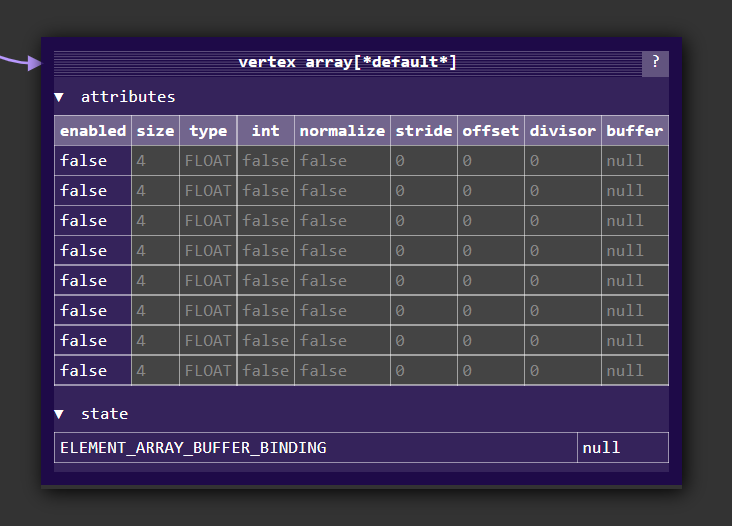I'm working through the excellent tutorials at arcsynthesis while building a graphics engine and have discovered I don't understand VAOs as much as I thought I had.
From the tutorial Chapter 5. Objects In Depth
Buffer Binding and Attribute Association
You may notice that glBindBuffer(GL_ARRAY_BUFFER) is not on that list, even though it is part of the attribute setup for rendering. The binding to GL_ARRAY_BUFFER is not part of a VAO because the association between a buffer object and a vertex attribute does not happen when you call glBindBuffer(GL_ARRAY_BUFFER). This association happens when you call glVertexAttribPointer.
When you call glVertexAttribPointer, OpenGL takes whatever buffer is at the moment of this call bound to GL_ARRAY_BUFFER and associates it with the given vertex attribute. Think of the GL_ARRAY_BUFFER binding as a global pointer that glVertexAttribPointer reads. So you are free to bind whatever you want or nothing at all to GL_ARRAY_BUFFER after making a glVertexAttribPointer call; it will affect nothing in the final rendering. So VAOs do store which buffer objects are associated with which attributes; but they do not store the GL_ARRAY_BUFFER binding itself.
I initially missed the last line "...but they do not store the GL_ARRAY_BUFFER binding itself". Before I noticed this line I thought that the currently bound buffer was saved once glVertexAttribPointer was called. Missing this knowledge, I built a mesh class and was able to get a scene with a number of meshes rendering properly.
A portion of that code is listed below. Note that I do not call glBindBuffer in the draw function.
// MESH RENDERING
/* ... */
/* SETUP FUNCTION */
/* ... */
// Setup vertex array object
glGenVertexArrays(1, &_vertex_array_object_id);
glBindVertexArray(_vertex_array_object_id);
// Setup vertex buffers
glGenBuffers(1, &_vertex_buffer_object_id);
glBindBuffer(GL_ARRAY_BUFFER, _vertex_buffer_object_id);
glBufferData(GL_ARRAY_BUFFER, _vertices.size() * sizeof(vertex), &_vertices[0], GL_STATIC_DRAW);
// Setup vertex attributes
glEnableVertexAttribArray(e_aid_position);
glEnableVertexAttribArray(e_aid_normal);
glEnableVertexAttribArray(e_aid_color);
glEnableVertexAttribArray(e_aid_tex);
glVertexAttribPointer(e_aid_position, 3, GL_FLOAT, GL_FALSE, sizeof(vertex), (GLvoid*)offsetof(vertex, pos));
glVertexAttribPointer(e_aid_normal, 3, GL_FLOAT, GL_FALSE, sizeof(vertex), (GLvoid*)offsetof(vertex, norm));
glVertexAttribPointer(e_aid_color, 4, GL_FLOAT, GL_FALSE, sizeof(vertex), (GLvoid*)offsetof(vertex, col));
glVertexAttribPointer(e_aid_tex, 2, GL_FLOAT, GL_FALSE, sizeof(vertex), (GLvoid*)offsetof(vertex, tex));
/* ... */
/* DRAW FUNCTION */
/* ... */
glBindVertexArray(_vertex_array_object_id);
glDrawArrays(GL_TRIANGLES, 0, _vertices.size());
Now that I'm about to start lighting I wanted to get some debug drawing up so I could verify all my normals are correct. Currently I just store all lines to be rendered for a frame in a vector. Since this data will likely change every frame, I'm using GL_DYNAMIC_DRAW and specify the data right before I render it.
Initially when I did this I would get garbage lines that would just point off into infinity. The offending code is below:
// DEBUG DRAW LINE RENDERING
/* ... */
/* SETUP FUNCTION */
/* ... */
// Setup vertex array object
glGenVertexArrays(1, &_vertex_array_object_id);
glBindVertexArray(_vertex_array_object_id);
// Setup vertex buffers
glGenBuffers(1, &_vertex_buffer_object_id);
glBindBuffer(GL_ARRAY_BUFFER, _vertex_buffer_object_id);
// Note: no buffer data supplied here!!!
// Setup vertex attributes
glEnableVertexAttribArray(e_aid_position);
glEnableVertexAttribArray(e_aid_color);
glVertexAttribPointer(e_aid_position, 3, GL_FLOAT, GL_FALSE, sizeof(line_vertex), (GLvoid*)offsetof(line_vertex, pos));
glVertexAttribPointer(e_aid_color, 4, GL_FLOAT, GL_FALSE, sizeof(line_vertex), (GLvoid*)offsetof(line_vertex, col));
/* ... */
/* DRAW FUNCTION */
/* ... */
glBindVertexArray(_vertex_array_object_id);
// Specifying buffer data here instead!!!
glBufferData(GL_ARRAY_BUFFER, _line_vertices.size() * sizeof(line_vertex), &_line_vertices[0], GL_DYNAMIC_DRAW);
glDrawArrays(GL_LINES, 0, _line_vertices.size());
After a bit of hunting, as well as finding the detail I missed above, I found that if I call glBindBuffer before glBufferData in the draw function, everything works out fine.
I'm confused as to why my mesh rendering worked in the first place given this. Do I only need to call glBindBuffer again if I change the data in the buffer? Or is behavior undefined if you don't bind the buffer and I was just unlucky and had it work?
Note that I am targeting OpenGL version 3.0.

